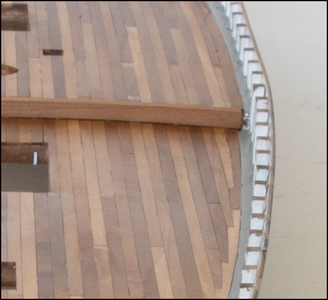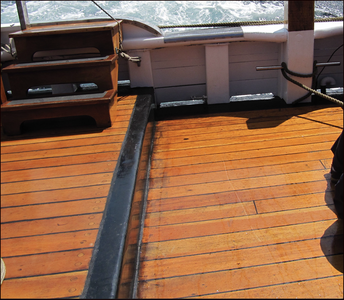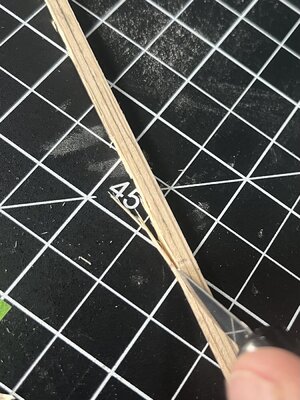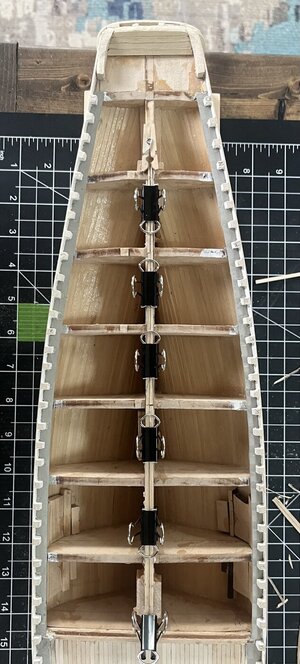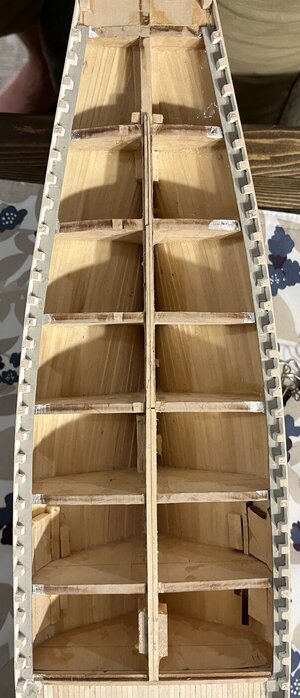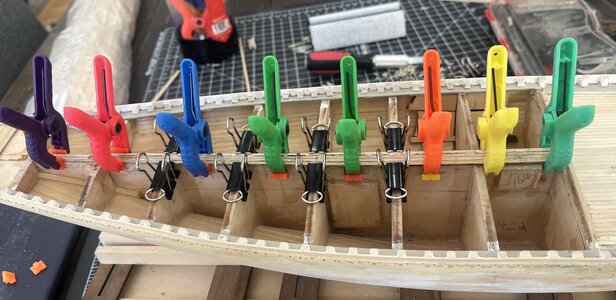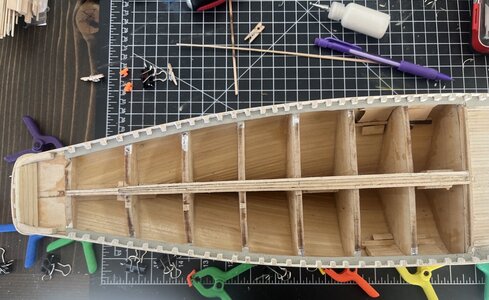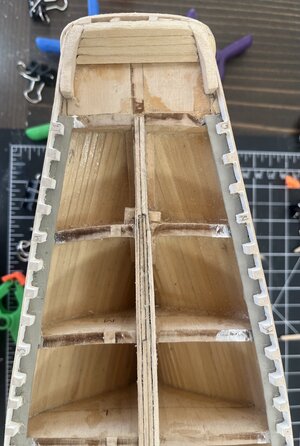7/30 to 8/3
Started sanding the foredeck. Started by using an 80 grit sanding block, then switched to an 80 grit emery board. I have an assortment of sanding sticks being delivered later today. These sticks should really help sanding in the bow.
While sanding I realized that on my last plank (the starboard one that was a plank and a half), I forgot to put in a butt. No one probably would have noticed, but I “cut” it in and drew it with a pencil.
More sanding is needed, but right now, it’s on to the quarterdeck.
Planing the quarterdeck is proving to be more challenging than the foredeck mostly due to two factors; about half of the planks are tapered, and I’m not running the planks the full length of the quarterdeck (I’ll make them 5 bulkheads in length, the same as I did on the foredeck).
Scouring through many BN build logs, it’s difficult to find any that detail my scenario and then only a few that show pictures, and of those few pictures, most do not show the area around the steering wheel and boom crutch with enough detail to map this out in my head. So in other words, I’m winging it.
Here’s what I know…
- The 2 center-most planks do not run from the great beam to the transom; they run from the great beam to about the steering wheel (one bulkhead in from the transom).
- The next 2 planks (one on each side) run from the great beam to the boom crutch and are “nibbed” around the end of the 2 center-most planks (that end at the steering wheel).
- These 4 planks seem to create the gentle curve of the planks out to the side of the transom and from there, the planks are nibbed.
- All of these planks are to be tapered to about 1/2 their width over about 6”. So the plank is 3/32” wide and I’m supposed to taper it down to about 3/64”. That’s just crazy, but I’m going to give it a try.
First I’m going to temporarily forget about the planks only running 5 bulkheads and focus on the 2 center-most planks and their taper. I feel if I can get these 2 “right”, the rest of the quarterdeck will fall into place.
I tried to taper one of these three times, and while each one was better that the one before it, none of them looked like I wanted them to. And there wouldn’t be much of a chance that I could duplicate it for the one on the other side.
I then had the idea to glue 2 planks together and taper both of the outside edges. Bigger board, hopefully easier to work with. I’m pretty sure it will work, BUT I probably can’t completely glue the planks together since I’m going to stick to my plank length of 5 bulkheads. So I did some quick calculations and determined that each of these center planks will have a butt. The plank on the port side will have a a butt at bulkhead K and the one on the starboard side will have a butt at bulkhead M.
View attachment 387933
I cut two lengths of planks that were long enough to go from just before the great beam to just after where the end of the planks are by the steering wheel. I used small clips to hold the planks together and marked the:
- End of the planks by the steering wheel, which is also where the taper ends
- Location of bulkhead K
- Location of bulkhead M
- 6” towards the great beam where the taper starts
- End of the plank at the great beam
I then put a dot of glue on both ends of the planks plus a line of glue between the marks for bulkhead K and M. I then clamped them together.
After drying, I drew lines of where the taper should be and started cutting off the excess. To be honest, I cut the 1st one way too fast and I messed it up. So onto a 2nd set. This time I took my time to cut each side, and then sanded the tapers. B I N G O! It looked awesome.
View attachment 387934
View attachment 387935
I then cut the ends off, and then cut the individual planks where the butts were to be. I marked up the sides with a pencil. I added glue along the top of the keel and centered the planks from the great beam to where the steering wheel will be located. I clamped everything to the top of the keel and after a few minutes, scraped the excess glue off. I then reclamped and let everything fully dry.
View attachment 387936
Overall I’m very happy with these 1st two planks, but should not have originally cut both planks at the great beam. I should have only cut the one on the port side as the one on the starboard side will have a butt which takes just a little bit of the plank away. If you look, this butt is a bit wider than what I’d like it to be, but I’ll live with it.
View attachment 387937
The above sounds LONG, but in the big picture it’s wasn’t too bad and feel the 1st two tapered planks look great. And with them glued in place, the 2nd set should not be near as time consuming.
Ok, on to the 2nd set of planks. I started by cutting 2 lengths of planks that are slightly longer than what they need to be, with about 1/16” extra at both ends. After drawing a line on each plank representing the 6” taper, I notched out where the 1st pair of planks ended (at the steering wheel) and cut the remaining taper on the inside of each plank. I then added a small taper on the outside of each plank from the “notch” to end of the planks (at the boom crutch).
After dry fitting both planks, I marked where the butts will be (remember I’m sticking with the plank lengths being 5 bulkheads). There will be 2 butts on the port side (bulkheads N and H) and one on the starboard side (at bulkhead J).
Learning from the 1st pair, I’ll do my glueing from the stern forward. This will help to ensure that the planks butt up cleanly to the great beam.
I cut the planks at N on the port side and J on the starboard side and sanded the edges. I finally penciled the edges and glued these on the quarterdeck. I then repeated this for the 3 remaining pieces of these planks, finally ending up with a nice butt for each side at the great beam.
After a few minutes of drying, I scraped the excess glue and reclamped.
And yes this pair, as hoped, was a lot quicker.
View attachment 387938
View attachment 387939
View attachment 387940
9.5 hours for some sanding on the foredeck and installing four planks on the quarterdeck is a bit painful, but from the beginning, I felt getting these first planks in would set the stage for the rest of the quarterdeck.
That’s it for now as I need to pack for Mexico as we leave early Saturday morning. It’s only a week long trip, but hopefully I’ll get to work at least a little bit on my Molino.
Work time: 9.5 hours
Total work time: 127.5 hours



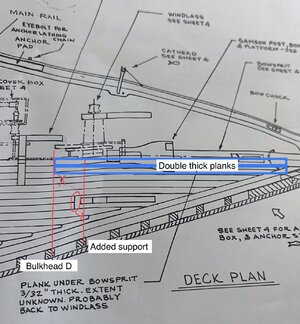
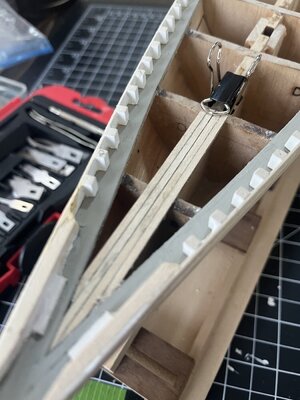
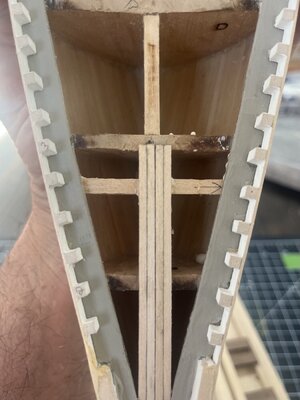
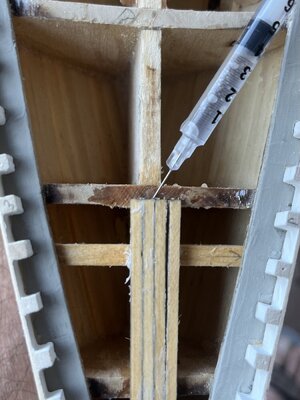
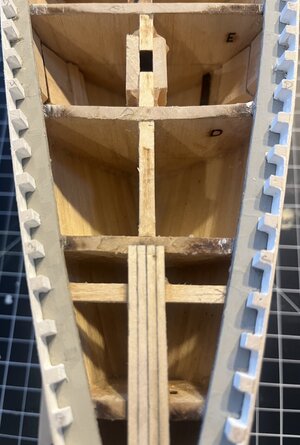
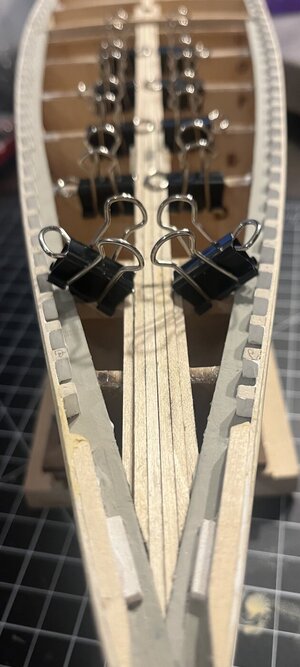
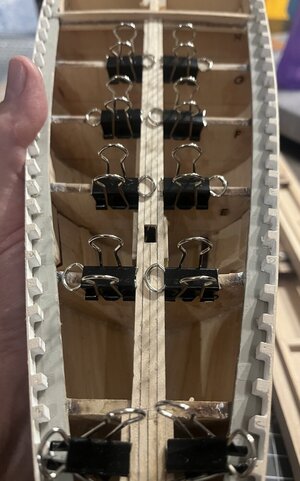




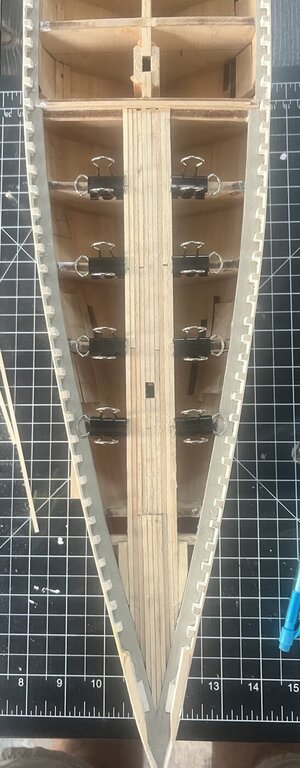
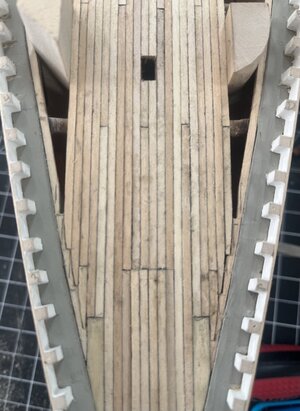
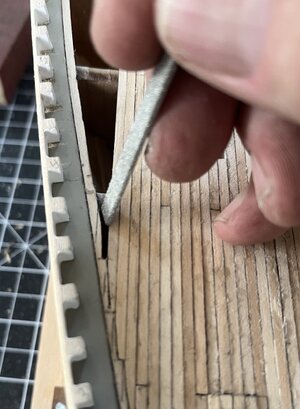
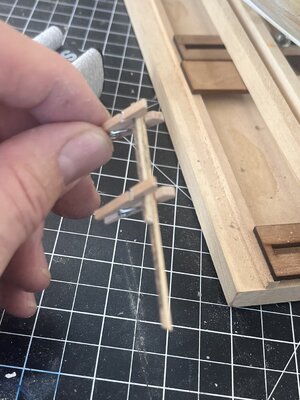
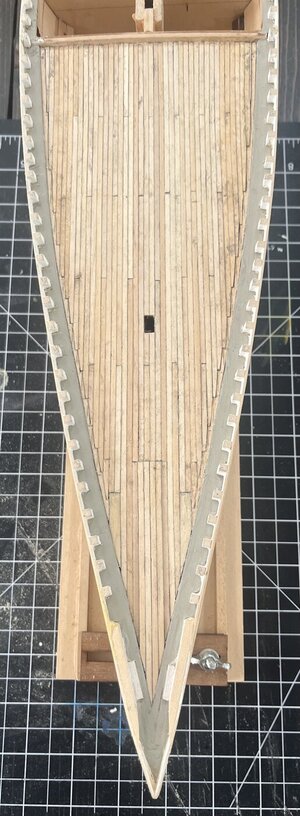
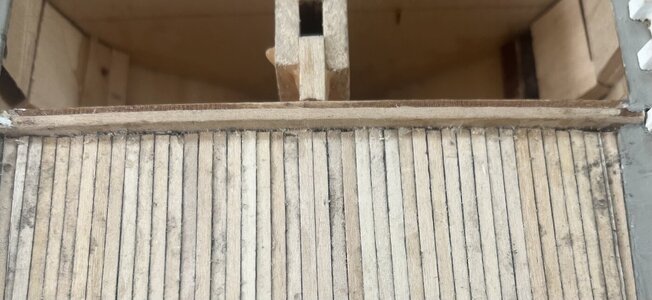
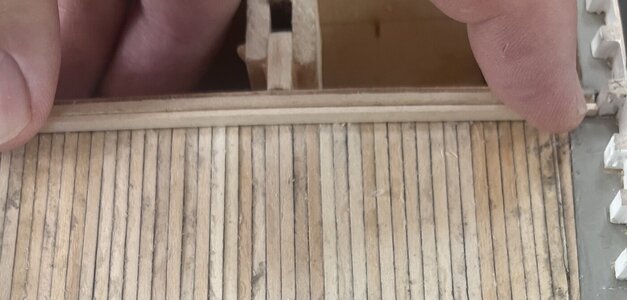
 Looks great!
Looks great!